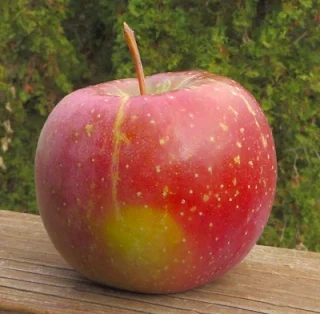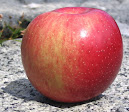
|
You know Honeycrisp (right?) even if you don't follow this blog. If you read my regular reports, perhaps you recall last fall's Evercrisp.
As its name suggests, Evercrisp, at right, takes aim at Honeycrisp and seeks to fill its shoes. Not by being boldly different, but by being the same only better.
So, this is personal. Let's see how things shake down.
Though not "separated at birth," these two apples could be related (and they are).
Both are hefty enough that I put off this contest until I was hungry. In this case my Honeycrisp is the larger of the two.
Both apples are decorated with large tan lenticel dots. Both are moderately ribbed and a little blocky, and both a little asymmetrical. They each come off as solid hunks of fruit.

|
| Honeycrisp |
With its brilliant orange-tinted red blush over yellow, Honeycrisp takes the beauty prize with ease. Evercrisp's blush is more subdued and a little muddied, and the peel is greasier.
But it's what's inside that counts most with me. (And, attend: that "greasy" peel is a feature, not a bug.)
Honeycrisp is not a keeper. In February, straight from commercial storage, it is still awfully crisp and sweet, but not nearly as much on both scores as in September.
The aged version actually tastes better because the sugar is not so suffocating and you can even make out flavors. These include a savory B-vitamin note and a hint of melon.
There is even a faint tart accent that comes through, at least when I switch back from the Evercrisp. But the crunch, though still very good, has suffered.

|
| Evercrisp |
Honeycrisp is nonetheless still mostly about crisp, juicy, and sweet. However, many of its signature qualities are notably deteriorated.
With Honeycrisp still fresh in my mouth, biting into Evercrisp is interesting. Evercrisp has a great crunch, tons of juice, and lots of sugar.
Its corn-syrup-floral-honey bouquet of flavors is unchanged from early December. I am also noticing a grassy note that is not entirely from the peel.
Compared to Honeycrisp, Evercrisp is denser and more substantial, and that peel is chewier. So let's note that the thicker, waxier peel protects Evercrisp from loss of moisture in storage.
That and the fruit's greater density help to make Evercrisp a solid keeper apple that retains its eating qualities in storage.
(That wax is natural cuticle wax from the apple, by the way.)
Let's also pause to admire the bit of positioning that Evercrisp's creators, the Midwest Apple Improvement Association, has performed with the name of of its Honeycrisp challenger.
"Evercrisp" says, "As good as Honeycrisp, but for longer." The apple largely delivers on that promise. It's even a little sweeter than Honeycrisp at this point.
There's really no contest in this head-to-head. As I switch back and forth, Evercrisp is the better apple in terms of both texture and flavor.
Would that be true when the Honeycrisps are fresh off the tree in September? That's impossible to say, because Evercrisp does not ripen until a month later.
So if you like this kind of apple, not only do you not have to choose in early fall, you can't. But I think that Honeycrisp fans may want to check out this latest rival in the winter and, perhaps, the spring.
Honeycrisp, watch your back.
Links- Honeycrisp and Evercrisp
- the Midwest Apple Improvement Association
- cuticle wax
- More smackdowns, two with Honeycrisp, vs. McIntosh and vs. Topaz
- Other apples to try if you like Honeycrisp

Totally agree. Tasting your first EverCrisp is an epiphany. Too bad they are so hard to find.
ReplyDeleteI don't know where you live or who grows these there, but compared to many of the modern varieties it is relatively easy to get permission to grow them. So, ask around, you may be pleasantly surprised!
DeleteI found that the Evercrisp was nowhere close to beating out the Honeycrisp. I'm spoiled to live close to orchards; it has made me a snob...I cannot buy any apple in the supermarket.
DeleteNever tried them until this week 100% over honey crisp
ReplyDeleteTried Evercrisp. Little bland, compared to Ruby Rush or Goldrush. Juicy and crunchy, but where's the flavor? Not surprised to find Honeycrisp in its parentage...
ReplyDelete